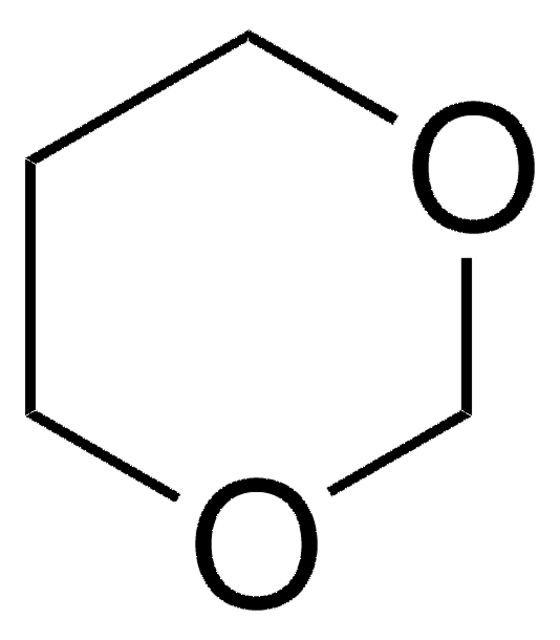D201863
1,4-Dioxan
ReagentPlus®, ≥99%, contains ≤25 ppm BHT as stabilizer
Synonym(e):
Diethylenoxid, Dioxan
About This Item
Empfohlene Produkte
Dampfdichte
3 (vs air)
Qualitätsniveau
Dampfdruck
27 mmHg ( 20 °C)
40 mmHg ( 25 °C)
Produktlinie
ReagentPlus®
Assay
≥99%
Form
liquid
Selbstzündungstemp.
356 °F
Enthält
≤25 ppm BHT as stabilizer
Expl.-Gr.
22 %
Methode(n)
thin layer chromatography (TLC): suitable
Brechungsindex
n20/D 1.422 (lit.)
pH-Wert
6.0-8 (20 °C, 500 g/L)
bp
100-102 °C (lit.)
mp (Schmelzpunkt)
10-12 °C (lit.)
Dichte
1.034 g/mL at 25 °C (lit.)
SMILES String
C1COCCO1
InChI
1S/C4H8O2/c1-2-6-4-3-5-1/h1-4H2
InChIKey
RYHBNJHYFVUHQT-UHFFFAOYSA-N
Suchen Sie nach ähnlichen Produkten? Aufrufen Leitfaden zum Produktvergleich
Verwandte Kategorien
Anwendung
- To synthesize 1,3-diamines and amino alcohols via 2-azaallyl anion benzylic ring-opening of aziridines.
- In the RAFT polymerization of acryclic acid.
- In the synthesis of cross-linked triblock copolymer hydrogels.
Rechtliche Hinweise
Ähnliches Produkt
Signalwort
Danger
H-Sätze
Gefahreneinstufungen
Carc. 1B - Eye Irrit. 2 - Flam. Liq. 2 - STOT SE 3
Zielorgane
Respiratory system
Zusätzliche Gefahrenhinweise
Lagerklassenschlüssel
3 - Flammable liquids
WGK
WGK 3
Flammpunkt (°F)
51.8 °F - closed cup
Flammpunkt (°C)
11 °C - closed cup
Analysenzertifikate (COA)
Suchen Sie nach Analysenzertifikate (COA), indem Sie die Lot-/Chargennummer des Produkts eingeben. Lot- und Chargennummern sind auf dem Produktetikett hinter den Wörtern ‘Lot’ oder ‘Batch’ (Lot oder Charge) zu finden.
Besitzen Sie dieses Produkt bereits?
In der Dokumentenbibliothek finden Sie die Dokumentation zu den Produkten, die Sie kürzlich erworben haben.
Kunden haben sich ebenfalls angesehen
Unser Team von Wissenschaftlern verfügt über Erfahrung in allen Forschungsbereichen einschließlich Life Science, Materialwissenschaften, chemischer Synthese, Chromatographie, Analytik und vielen mehr..
Setzen Sie sich mit dem technischen Dienst in Verbindung.








